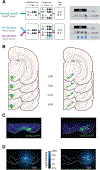Ventral Tegmental Dopamine Neurons Participate in Reward Identity Predictions
- PMID: 30581025
- PMCID: PMC6324975
- DOI: 10.1016/j.cub.2018.11.050
Ventral Tegmental Dopamine Neurons Participate in Reward Identity Predictions
Abstract
Dopamine (DA) neurons in the ventral tegmental area (VTA) and substantia nigra (SNc) encode reward prediction errors (RPEs) and are proposed to mediate error-driven learning. However, the learning strategy engaged by DA-RPEs remains controversial. RPEs might imbue predictive cues with pure value, independently of representations of their associated outcome. Alternatively, RPEs might promote learning about the sensory features (the identity) of the rewarding outcome. Here, we show that, although both VTA and SNc DA neuron activation reinforces instrumental responding, only VTA DA neuron activation during consumption of expected sucrose reward restores error-driven learning and promotes formation of a new cue→sucrose association. Critically, expression of VTA DA-dependent Pavlovian associations is abolished following sucrose devaluation, a signature of identity-based learning. These findings reveal that activation of VTA- or SNc-DA neurons engages largely dissociable learning processes with VTA-DA neurons capable of participating in outcome-specific predictive learning, and the role of SNc-DA neurons appears limited to reinforcement of instrumental responses.
Keywords: blocking; conditioning; dopamine; learning; model-based; model-free; optogenetics; reward-prediction error; substantia nigra; ventral tegmental area.
Copyright © 2018 Elsevier Ltd. All rights reserved.
Conflict of interest statement
DECLARATION OF INTERESTS
The authors declare no competing interests.
Figures





Similar articles
-
From Prediction to Action: Dissociable Roles of Ventral Tegmental Area and Substantia Nigra Dopamine Neurons in Instrumental Reinforcement.J Neurosci. 2023 May 24;43(21):3895-3908. doi: 10.1523/JNEUROSCI.0028-23.2023. Epub 2023 Apr 25. J Neurosci. 2023. PMID: 37185097 Free PMC article.
-
Cue and Reward Evoked Dopamine Activity Is Necessary for Maintaining Learned Pavlovian Associations.J Neurosci. 2021 Jun 9;41(23):5004-5014. doi: 10.1523/JNEUROSCI.2744-20.2021. Epub 2021 Apr 22. J Neurosci. 2021. PMID: 33888609 Free PMC article.
-
Ventral tegmental area and substantia nigra neural correlates of spatial learning.Learn Mem. 2011 Mar 29;18(4):260-71. doi: 10.1101/lm.1895211. Print 2011 Apr. Learn Mem. 2011. PMID: 21447624
-
Expression of receptors for insulin and leptin in the ventral tegmental area/substantia nigra (VTA/SN) of the rat: Historical perspective.Brain Res. 2016 Aug 15;1645:68-70. doi: 10.1016/j.brainres.2015.12.041. Epub 2015 Dec 28. Brain Res. 2016. PMID: 26731335 Review.
-
Mesoaccumbal Dopamine Heterogeneity: What Do Dopamine Firing and Release Have to Do with It?Annu Rev Neurosci. 2022 Jul 8;45:109-129. doi: 10.1146/annurev-neuro-110920-011929. Epub 2022 Feb 28. Annu Rev Neurosci. 2022. PMID: 35226827 Free PMC article. Review.
Cited by
-
Dynamics of Lateral Habenula-Ventral Tegmental Area Microcircuit on Pain-Related Cognitive Dysfunctions.Neurol Int. 2023 Oct 27;15(4):1303-1319. doi: 10.3390/neurolint15040082. Neurol Int. 2023. PMID: 37987455 Free PMC article. Review.
-
Distinct temporal difference error signals in dopamine axons in three regions of the striatum in a decision-making task.Elife. 2020 Dec 21;9:e62390. doi: 10.7554/eLife.62390. Elife. 2020. PMID: 33345774 Free PMC article.
-
Neuronal activity in the ventral tegmental area during goal-directed navigation recorded by low-curvature microelectrode arrays.Microsyst Nanoeng. 2024 Oct 14;10(1):145. doi: 10.1038/s41378-024-00778-2. Microsyst Nanoeng. 2024. PMID: 39396959 Free PMC article.
-
Dopamine D2 receptor signaling on iMSNs is required for initiation and vigor of learned actions.Neuropsychopharmacology. 2020 Nov;45(12):2087-2097. doi: 10.1038/s41386-020-00799-1. Epub 2020 Aug 18. Neuropsychopharmacology. 2020. PMID: 32811899 Free PMC article.
-
Dopamine signals as temporal difference errors: recent advances.Curr Opin Neurobiol. 2021 Apr;67:95-105. doi: 10.1016/j.conb.2020.08.014. Epub 2020 Nov 10. Curr Opin Neurobiol. 2021. PMID: 33186815 Free PMC article. Review.
References
-
- Schultz W, Dayan P, and Montague PR (1997). A neural substrate of prediction and reward. Science 275, 1593–1599. - PubMed
-
- Waelti P, Dickinson A, and Schultz W (2001). Dopamine responses comply with basic assumptions of formal learning theory. Nature 412, 43–48. - PubMed
-
- Rescorla RA, and Wagner AR (1972). A theory of pavlovian conditioning: variations in the effectiveness of reinforcement and nonreinforcement In Classical conditioning II: current research and theory, Black AH and Prokasy WF, eds. (New York: Appleton-Century-Crofts; ), pp. 64–99.
Publication types
MeSH terms
Grants and funding
LinkOut - more resources
Full Text Sources
Other Literature Sources

